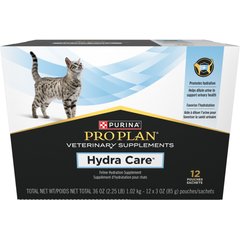Addison’s Disease in Cats
What Is Addison’s Disease in Cats?
Addison’s disease (also called hypoadrenocorticism) affects the adrenal glands, which produce hormones such as cortisol that are vital to the healthy function of many of the body’s systems. A lack of these hormones can have devastating effects on a cat’s health.
In cats, the adrenal glands are found in front of the kidneys, and the hormones produced help control:
-
Electrolytes: Aldosterone is one of the hormones involved with balancing electrolytes, which affect hydration.
-
Glucocorticoids (such as cortisol): These hormones affect numerous functions such as the immune system, regulating glucose, fat, and protein metabolism.
-
Sexual function: The adrenals are responsible for producing sex hormones such as progesterone, estrogen, and androgens.
Addison’s disease is very rare in cats. Although rare, Addison’s should be considered a medical emergency because the disease impacts so many vital systems.
Vet Recommended Health Support
- Feliway Optimum Enhanced Calming 30 Day Diffuser for Cats$29.99Chewy Price
- Purina Pro Plan Veterinary Diets FortiFlora Powder Probiotic Digestive Supplement for Cats, 30 count$30.99Chewy Price
- Purina Pro Plan Veterinary Diets Hydra Care Liver Flavored Liquid Supplement for Cats, 3-oz pouch, case of 12$14.99Chewy Price
- Purina Pro Plan Adult Sensitive Skin & Stomach Lamb & Rice Formula Dry Cat Food, 7-lb bag$28.08Chewy Price
Symptoms of Addison’s Disease in Cats
Symptoms are sporadic and can often include vomiting or gastrointestinal upset that may be brought on or worsened by stress or another illness. Most cats experience some of the following symptoms:
-
Decreased appetite and/or weight loss
-
Malaise and weakness
-
Dehydration, with increased thirst and urination
-
Slow capillary refill time, in which a veterinarian presses on gums and counts the seconds until the area refills with blood
-
Low blood pressure and/or heart rate
-
Vomiting
Diarrhea may also occur, though not as frequently as other symptoms. Other signs include those related to shock, such as cooler than normal limbs or paws; pale or discolored gums; shallow or rapid breathing; or rapid or absent pulses.
Causes of Addison’s Disease in Cats
Addison’s disease, while rare, does not seem to be associated with any breed or particular age. Although the cause is unknown, it may be due to an autoimmune condition in which a cat’s immune system attacks and destroys the adrenal glands.
In addition, Addison’s has been associated with lymphoma or the sudden withdrawal of steroid therapy.
How Veterinarians Diagnose Addison’s Disease in Cats
Addison’s disease is diagnosed through a combination of blood tests and a history of symptoms associated with the disease. Blood tests, such as a complete blood cell count (CBC), check for:
-
Changes in a cat’s white blood cell pattern
-
Increase in eosinophils, a type of white blood cell
Other tests will look for an increase in blood urea nitrogen (BUN) and phosphorus. A vet will look for electrolyte imbalance (such as high potassium or low sodium, which can affect the heart’s rhythm).
ACTH Test for Cats
If a vet suspects Addison’s, a test called ACTH (adrenocorticotropic hormone) will be ordered. This test evaluates adrenal function and mimics what is naturally (or should be) occurring in the cat.
ACTH hormone is produced by the pituitary gland, which acts on the adrenals to produce the hormone cortisol. In the hospital, a blood sample is taken from the cat to measure the baseline cortisol. Then a synthetic ACTH is administered, and another blood sample is taken from the cat an hour later and compared with the first. In cases of Addison’s, there will be minimal to no increase of cortisol.
Additional tests that may be recommended include:
-
Urinalysis to look for evidence of kidney disease and concentration of the urine
-
Blood pressure to diagnose hypotension and response to IV fluid therapy
-
Chest X-rays to look for heart issues (microcardia)
-
ECG to determine the presence of arrhythmias and evidence of electrolyte issues
Treatment of Addison’s Disease in Cats
Although there is no cure, Addison’s disease is manageable and cats can enjoy long, active and happy lives.
If symptoms are severe, initial treatment will focus on stabilizing the cat. Dehydration, hypovolemia, anemia, vomiting, or electrolyte derangements often require aggressive fluid therapy, and possibly blood transfusions. If required, various medications will be given. Several days of hospitalization may be needed.
Addison’s disease occurs due to a lack of steroids, so the treatment of choice is steroid replacement therapy, often with prednisolone or depo-medrol. This can be given as a pill, liquid, or monthly injection. Therapy may be coupled with a synthetic mineralocorticoid (desoxycorticosterone pivalate, or DOCP), an injectable given about once every month, or fludrocortisone acetate, an oral medication given daily, are the treatments of choice.
Recovery and Management of Addison’s Disease in Cats
Once your cat is discharged, your veterinarian may recommend a follow-up exam with bloodwork in a few weeks after starting these medications. The dose and frequency of both medications will be influenced by the results, and it may take several follow-up visits before the dose is correct and working properly.
Once stable and well-managed, your cat may still need to have her electrolytes checked prior to every DOCP injection and they should continue to be examined frequently, about once every 3 to 6 months, or as directed by your veterinarian. Dosing can change over time due to the disease.
Many of the symptoms initially experienced take several days to resolve and if initial treatment is successful, the long-term prognosis is good. Be sure to adhere to your veterinarian’s recheck and follow-up guidelines and remember that your cat requires lifelong medication!
And because cortisol is needed to adapt to stressful situations, in Addisonian cats, even small stressors could have serious consequences. It’s recommended that during periods of increased stress and illness you speak with your veterinarian about the need to increase the dose of your cat’s medication.
Addison’s Disease in Cats FAQs
Can a pet parent prevent Addison’s disease in cats?
Addison’s disease cannot be prevented, but understanding the condition can ensure your cat receives prompt veterinary attention, which in turn can increase the likelihood of a more favorable outcome.
What is the life expectancy of a cat with Addison’s disease?
With proper management and follow-up, the long-term prognosis is good, except for cats in which the underlying cause is due to cancer.
What is an Addisonian crisis in cats?
An Addisonian crisis is a life-threatening medical emergency characterized by hypovolemic shock (due to loss of bodily fluid), low blood pressure, and electrolyte issues, and the cat is often unable to rise. It is treated with aggressive fluid therapy, steroids, dextrose (sugar replacement), and other medications designed to restore normal body functions and reverse the effects of shock.
Featured Image: iStock.com/.shock
References
Peterson ME, Greco DS, Orth DN. Primary Hypoadrenocorticism in Ten Cats. Journal of Veterinary Internal Medicine. 1989;3(2):55-58.
Sicken J, Neiger R. Addisonian crisis and severe acidosis in a cat: a case of feline hypoadrenocorticism. Journal of Feline Medicine and Surgery. 2013;15(10):941-944.
Ettinger SJ, Feldman EC, Etienne Côté. Textbook of Veterinary Internal Medicine: Diseases of the Dog and the Cat. Saunders; 2017.




